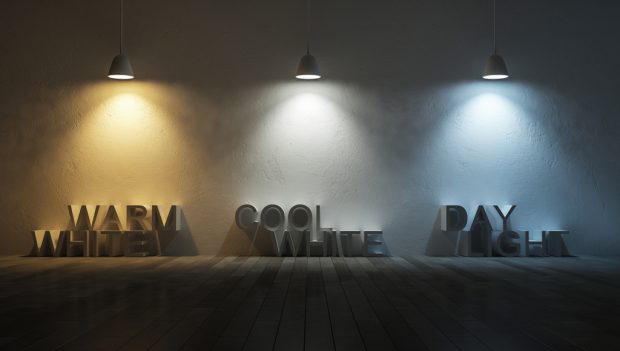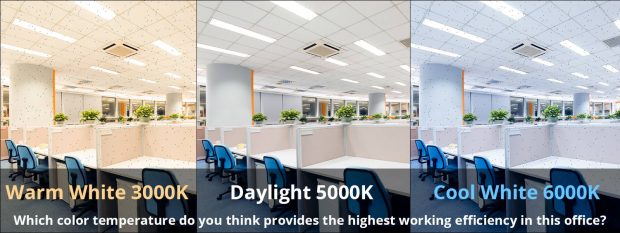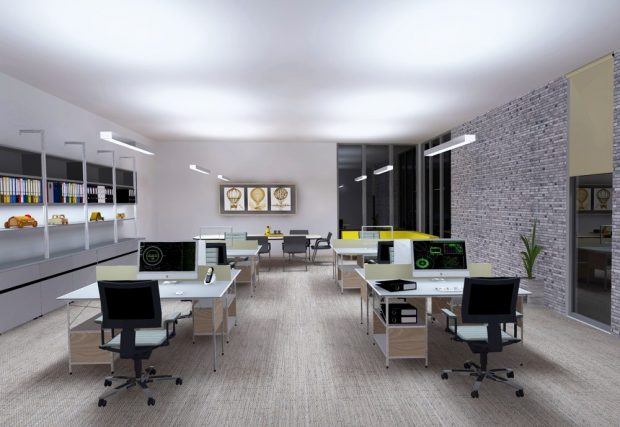The same way you need to equip an office with the right furniture and supplies, you also need to pay attention to suitable lighting. One thing to consider is the IP value of lamps, but this mostly goes for areas where protection against water and dust is important, such as bathrooms, kitchens, and outdoor areas. Much more important consideration for both residential and commercial light applications is the color temperature. So let’s take a look which is the best one for an office.

From Candlelight to Cloudy Winter Day
The reason why the scale of LED lamps measured in Kelvin (K) is referred to as color temperature is that, as we move from 1000 to 10.000, the light goes from red, across orange and yellow, to white and in the end blue-white. We associate these colors with our experiences of hot and cool.
This perception is taken from Nature. The color temperature of candlelight is 1800K and the glow of a fire is around 2000K, so it gives a very warm look. Sunset at about 4000K gives a cooler, whiter look, an average sunny day around 5000K goes more towards cooler blue, while a cloudy winter day at 7000K provides quite a cool experience.
This has created a division into three categories. The first one is warm, going between 2000 and 3000K, with a range from red, across yellow, to orange. It creates an intimate atmosphere, cozy and calm. The second one is neutral, going between 3100 and 4500K, the range has much less yellow and is a lot bluer. It creates a lively and clear atmosphere, striking a balance between too hot and too intense blue. The third one is daylight, going between 4600 and 6500K, the range has much more blue and white. It creates an atmosphere perfect for concentration and staying on alert.

The Question of Productivity
Now that we’ve gone over categories, let’s see what’s the most suitable one for an office. Numerous studies have dealt with the health benefits of daylight, as well as the connection between color temperature and productivity. The results have shown that working under cooler light results in higher productivity compared with working under the warmer one.
The test subjects working under cooler light experienced an increase of alertness, vitality, and mental acuity, they experienced less sleepiness and were overall less tired. The trick lies in the production of melatonin, which is reduced under blue light. This hormone is what makes us drowsy, so if a color temperature is too yellow it’s like a signal to our brains it’s time for a nap.
Since the question of productivity is crucial in any business, the daylight range of 5000k is the best choice for a general office setting. This color temperature keeps the employees concentrated and enables them to see everything clearly.

Different Parts
While there’s no doubt that the daylight color temperature will increase the enthusiasm of employees and therefore boost their productivity, most offices have other parts besides the general one. When it comes to the break room, the neutral temperature range with a hint of warmer yellow and orange light is much more suitable for relaxation and entertainment. The same thing goes for office corridor and lobby where the goal is to make both employees and visitors comfortable. As we’ve said, the neutral range is all about striking the perfect balance while the daylight one will keep employees concentrated and on alert during their tasks.
To sum up, when it comes to an office setting, you should keep the overall color temperature between 3500 and 5500K. Anything below 3500K is too yellow and will have a negative impact on productivity while anything above 5500K is simply too blue and can lead to agitation.
Read More:
How to create a cosy and environmentally friendly home office
Top things need in any business office
Easy and proven ways to enhance workplace teamwork
6 benefits of having great coffee in your office

